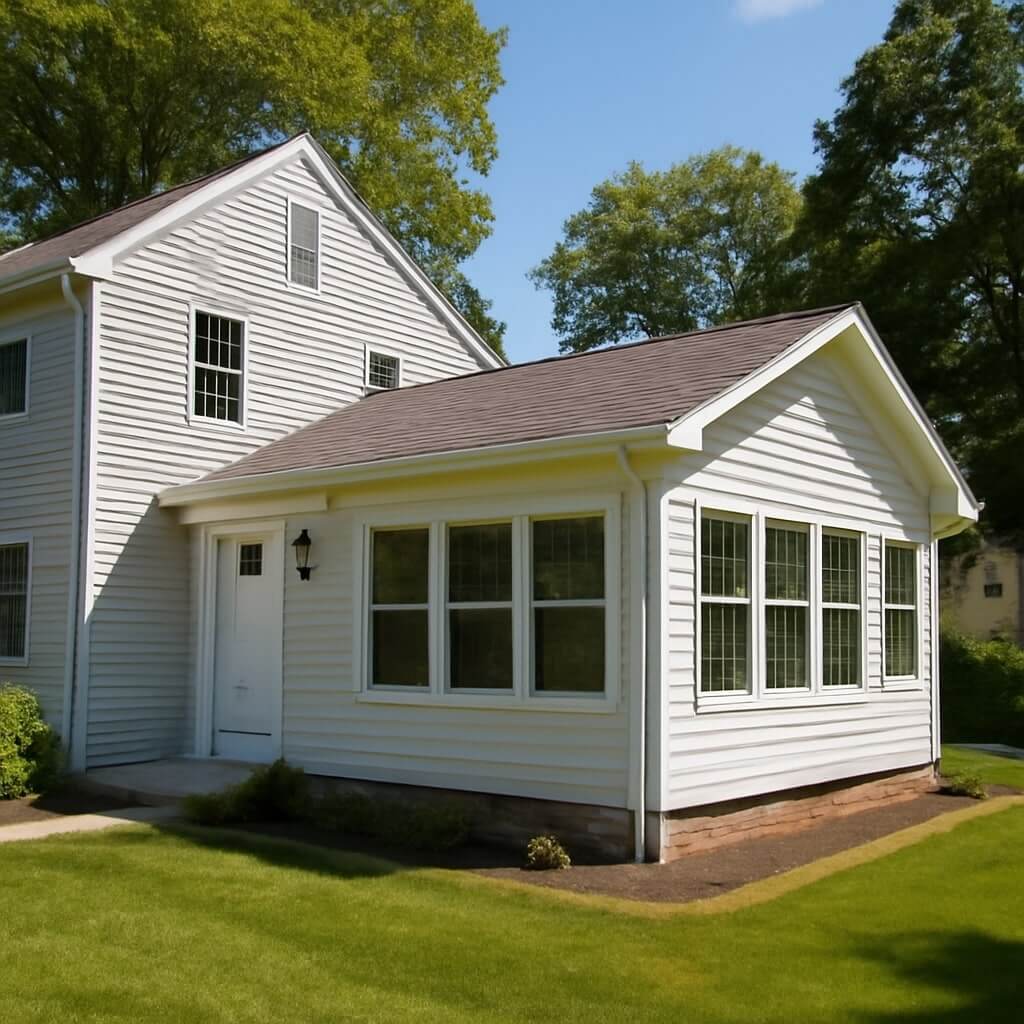Considering a home addition in Simsbury? You’ve got a lot to think about. It’s vital to assess your family’s current and future needs before jumping in. Understanding local building codes can save you from compliance headaches later. Plus, budgeting realistically is key to managing costs effectively. But there’s more to it than just the basics. Let’s explore essential tips that will set you on the right path for a successful project.
Key Takeaways
- Assess your family’s current and future needs to prioritize must-have features for your home addition.
- Research local zoning regulations and building codes in Simsbury to ensure compliance before starting your project.
- Create a detailed budget that includes potential unexpected expenses and gather quotes from qualified contractors.
- Communicate with neighbors about your plans to foster goodwill and address any concerns regarding construction disruptions.
- Incorporate energy-efficient materials and systems to enhance sustainability and reduce future maintenance costs.
Assess Your Needs and Goals
When considering a home addition, how do you determine what you truly need and want?
Start by evaluating your family needs and any recent lifestyle changes. Are you welcoming a new baby, or maybe a teenager needs their own space?
Consider how your daily routines may shift with an addition. Make a list of must-haves versus nice-to-haves; prioritize according to your family’s current and future needs.
Think about functionality—will the new space serve multiple purposes?
Research Local Building Codes and Regulations
Before diving into your home addition project, it’s crucial to familiarize yourself with local building codes and regulations, as these rules can greatly impact your plans.
Start by researching local building standards to guarantee your project meets safety and design requirements. Check with your town’s planning department for zoning regulations, which dictate how much you can build and where.
Understanding setback requirements, height restrictions, and permitted uses will help you avoid costly mistakes. Also, inquire about necessary permits to keep your project compliant.
Set a Realistic Budget
Setting a realistic budget is essential before starting your home addition project.
You’ll need to determine project costs, accounting for materials and labor, while also considering unexpected expenses that might arise.
Prioritizing must-have features will help you allocate your funds effectively and avoid overspending.
Determine Project Costs
Budgeting for a home addition can be a complex process, but it’s essential to start with a clear understanding of your financial landscape.
Begin with cost estimation by gathering quotes from contractors and suppliers. Consider materials, labor, permits, and any design fees.
Conduct a thorough budget analysis to identify your current expenses and savings potential. This will help you set a realistic budget that aligns with your goals.
Remember, knowing the total project costs upfront will allow you to make informed decisions and prevent financial strain later.
Stay organized and focused to keep your home addition on track and within budget.
Consider Unexpected Expenses
While you may have a solid budget in mind for your home addition, it’s crucial to account for unexpected expenses that can arise during the project.
Hidden costs and unexpected delays can quickly throw your budget off balance. Here are a few common areas where expenses might escalate:
- Permitting and inspection fees
- Unforeseen structural issues
- Changes in material costs
Prioritize Must-Have Features
To guarantee your home addition project stays on track, it’s essential to prioritize must-have features that align with your vision and budget.
Start by identifying key elements that enhance space utilization and create a functional layout. Consider how you’ll use the new space—whether it’s for a family room, office, or guest suite.
Make a list of these features, ranking them in order of importance. This approach helps prevent overspending on less critical aspects while ensuring the addition meets your needs.
Hire the Right Contractor
Choosing the right contractor can make or break your home addition project, so it’s crucial to invest time in the selection process.
Look for professionals with strong contractor qualifications and relevant project experience. Here are a few tips to help you find the best fit:
- Check online reviews and ask for referrals from friends or family.
- Verify licenses and insurance to guarantee compliance with local regulations.
- Request detailed quotes and timelines to compare different contractors effectively.
Consider Design and Aesthetics
When planning your home addition, it’s crucial to match the new structure with your existing architecture to create a cohesive look.
Choosing complementary materials can enhance the overall aesthetic and guarantee your addition feels like a natural part of your home.
Paying attention to these design elements won’t only boost your home’s appeal but also its value.
Match Existing Architecture
One key aspect of successful home additions is guaranteeing that the new structure harmonizes with the existing architecture.
Achieving architectural harmony and design continuity can elevate your home’s aesthetic appeal.
Consider these elements during your planning:
- Style: Match the architectural style of your home, whether it’s colonial, modern, or craftsman.
- Proportions: Confirm the addition’s size and scale complement the existing structure.
- Details: Incorporate similar design details, like windows, rooflines, and trim, to create a seamless shift.
Choose Complementary Materials
Achieving architectural harmony doesn’t stop with matching styles and proportions; selecting the right materials is equally important.
To guarantee material harmony, choose materials that complement your home’s existing aesthetics. Think about durability, color, and texture when selecting siding, roofing, and trim.
Consider how these choices will affect design integration with both the old and new sections of your home. For instance, if your home features brick, you might opt for a similar-toned stone or fiber cement that mimics its appearance.
Thoughtful material selection not only enhances visual appeal but also guarantees a cohesive look throughout your home addition.
Plan for Disruption and Timeline
Since home additions can considerably disrupt your daily routine, it’s crucial to plan for both the timeline and the potential inconveniences that come with construction.
Effective disruption management will help minimize stress. Set realistic timeline expectations to keep your project on track.
Consider the following:
- Identify peak construction times to prepare your family.
- Create a temporary living space, if necessary, to maintain comfort.
- Communicate regularly with your contractor for updates and adjustments.
Obtain Necessary Permits
Before starting your home addition, you’ll need to obtain the necessary permits to comply with local regulations.
Researching these rules early can save you time and headaches later, so make certain to submit your application promptly.
Consulting with professionals can also help guarantee that you meet all requirements and avoid costly mistakes.
Research Local Regulations
When you’re planning a home addition, understanding local regulations is essential to ensuring your project runs smoothly.
Before you begin, make sure you research:
- Zoning restrictions that may affect your design
- Required building permits for construction
- Local codes that dictate safety and aesthetic standards
These regulations can vary considerably, so it’s vital to familiarize yourself with the specific requirements in Simsbury.
Ignoring these guidelines can lead to costly delays or even the need to remove completed work.
Take the time to gather this information upfront, and you’ll pave the way for a successful and compliant home addition.
Submit Application Timely
As you move forward with your home addition project, submitting your application for permits in a timely manner is essential to avoiding unnecessary delays.
Familiarize yourself with the application process and keep track of submission deadlines. Delays in submitting your application can lead to extended wait times for approval, impacting your project timeline and budget.
Make sure you gather all required documentation and double-check that everything is complete before submission.
Consult With Professionals
Consulting with professionals is an essential step in the home addition process, especially if you want to guarantee all necessary permits are obtained without hassle.
By consulting local experts, you can navigate the complexities of regulations and ascertain compliance.
- Gain insight into local zoning laws
- Explore design options tailored to your home
- Streamline the permit application process
These professionals not only help you understand the requirements but also assist in avoiding costly mistakes.
Don’t overlook their expertise; it’ll save you time and frustration, allowing you to focus on creating the perfect space for your family.
Communicate With Neighbors
How can open communication with your neighbors improve your home addition project?
Establishing strong neighbor relations is essential. Before starting construction, take the time to discuss your plans with nearby residents. This not only shows respect but also invites valuable community feedback.
Neighbors may have insights about local regulations or potential issues that could arise during the project. Keeping them informed helps to mitigate concerns, reducing the likelihood of disputes.
Neighbors can offer valuable insights into local regulations and potential project issues, helping to reduce concerns and prevent disputes.
Additionally, showing consideration can foster goodwill, making it easier to navigate any challenges that arise. Open communication sets a positive tone, ultimately enhancing your project’s success and your neighborhood’s harmony.
Incorporate Energy Efficiency Features
Incorporating energy efficiency features into your home addition not only reduces energy costs but also enhances your home’s overall comfort and sustainability.
By making informed choices, you can create a space that’s both functional and eco-friendly. Consider the following upgrades:
- Install solar panels to harness renewable energy and lower utility bills.
- Choose energy efficient windows to improve insulation and reduce heating and cooling costs.
- Use energy-efficient appliances that consume less power without sacrificing performance.
These features not only add value to your home but also contribute to a greener future.
Embrace energy efficiency and enjoy long-term benefits in your living space.
Prepare for Future Maintenance and Upgrades
As you begin your home addition project, it’s essential to think ahead about maintenance and potential upgrades.
Start by selecting durable materials that require less upkeep, like fiber cement siding or energy-efficient windows. This choice not only eases maintenance but also supports future upgrades.
Incorporate accessible electrical and plumbing systems to simplify modifications later on. During the design phase, consider utility access points for easy repairs.
Conclusion
To sum up, planning your home addition in Simsbury requires careful consideration of your family’s needs, budget, and local regulations. By hiring a qualified contractor and maintaining open communication with your neighbors, you’ll minimize disruptions and foster goodwill. Don’t forget to incorporate energy-efficient features and durable materials for long-term sustainability and ease of maintenance. With these essential tips, you’re well on your way to creating a functional and valuable addition that enhances your living space.

